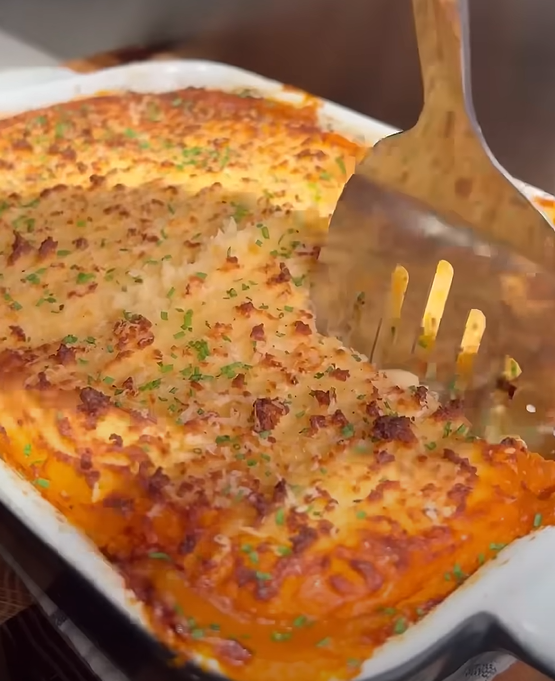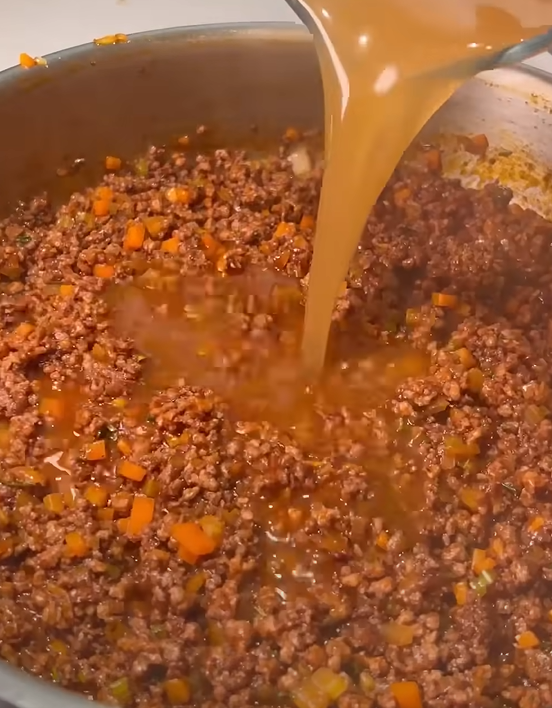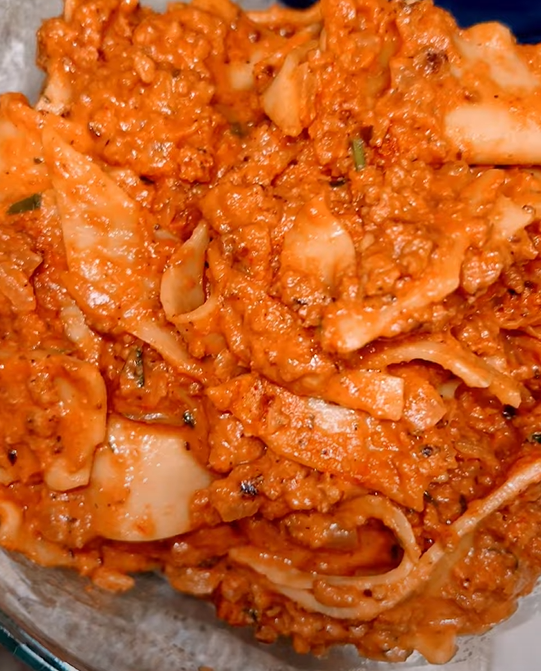When I first discovered chicken shepherd’s pie, I was skeptical. How could anything replace the traditional lamb or beef that makes this dish so iconic? But after years of perfecting my recipe and serving it to countless dinner guests, I can confidently say that chicken shepherd’s pie deserves a place at every family table. This lighter, more accessible version maintains all the comfort and satisfaction of the original while offering its own unique charm.
The beauty of chicken shepherd’s pie lies in its versatility and approachability. Unlike traditional versions that can be heavy and rich, chicken creates a more delicate flavor profile that appeals to both adults and children. I’ve found that families who might shy away from the stronger taste of lamb embrace this chicken variation with open arms.
What Makes Chicken Shepherd’s Pie Special
Shepherd’s Pie: Traditionally a British dish consisting of minced meat topped with mashed potatoes and baked until golden. The original version uses lamb (hence “shepherd’s”), while cottage pie uses beef.
Chicken Shepherd’s Pie: A modern adaptation using ground or diced chicken instead of traditional lamb, creating a milder flavor while maintaining the comfort food essence.
Flavor Profile: The chicken base allows other ingredients like vegetables, herbs, and seasonings to shine through more prominently than in heavier meat versions.
The transformation from lamb to chicken isn’t just about taste—it’s about accessibility. Ground chicken is typically more affordable than lamb and more readily available in most grocery stores. I’ve also noticed that chicken cooks faster and absorbs flavors more readily, making this version perfect for weeknight dinners when time is limited.
Essential Ingredients and Their Roles
Creating the perfect chicken shepherd’s pie requires understanding how each component contributes to the final dish. I’ve learned through trial and error that quality ingredients make an enormous difference in the outcome.
The Chicken Foundation
For the meat layer, I prefer using a combination of ground chicken thigh and breast meat. The thigh meat provides richness and prevents the filling from becoming too dry, while the breast meat adds a cleaner flavor. If you can only find one type, ground chicken thigh is my top recommendation—it has more flavor and stays moist during the cooking process.
Ground Chicken Selection Tips:
- Look for packages with at least 15% fat content
- Fresh ground chicken should have a pink color with no gray undertones
- Avoid pre-seasoned varieties for better control over flavors
- Purchase from a reputable butcher when possible
Vegetable Medley
The vegetable layer provides texture, nutrition, and flavor complexity. My standard combination includes carrots, peas, onions, and celery, but I’ve experimented with numerous variations over the years.
Primary Vegetables:
- Carrots: Provide natural sweetness and vibrant color
- Peas: Add pop of color and fresh flavor
- Onions: Create the aromatic foundation
- Celery: Contributes subtle flavor and satisfying crunch
Optional Additions:
- Corn: Adds sweetness and texture variation
- Mushrooms: Provide earthy umami depth
- Bell peppers: Contribute color and mild flavor
- Leeks: Offer a more sophisticated onion flavor
The Perfect Potato Topping
The mashed potato crown is arguably the most important component—it’s what transforms this from a simple chicken and vegetable mixture into true shepherd’s pie. I’ve discovered that the key lies in the potato variety and preparation method.
Best Potato Varieties:
- Russet potatoes: High starch content creates fluffy, light mashing
- Yukon Gold: Naturally buttery flavor with creamy texture
- Red potatoes: Lower starch but excellent for chunky texture preferences
My secret to exceptional mashed potatoes involves cooking them in chicken stock instead of plain water. This technique infuses flavor throughout the potatoes rather than just on the surface.
Detailed Preparation Method
Step 1: Preparing the Potato Topping
I always start with the potatoes because they take the longest and can be kept warm while preparing other components.
- Peel and cut 2.5 pounds of potatoes into uniform chunks (about 2 inches)
- Place in cold, salted chicken stock to cover by 2 inches
- Bring to boil, then reduce heat and simmer until fork-tender (15-20 minutes)
- Drain thoroughly and return to pot
- Mash with butter, warm milk, salt, and white pepper
- Taste and adjust seasonings
Pro Tip: I let the drained potatoes sit in the hot pot for 2-3 minutes before mashing. This extra step evaporates excess moisture, preventing watery mashed potatoes.
Step 2: Building the Flavor Base
The foundation of great chicken shepherd’s pie starts with proper aromatics. I use a technique called “sweating” vegetables, which draws out their natural flavors without browning.
- Heat 2 tablespoons olive oil in large skillet over medium heat
- Add diced onions and cook until translucent (5-6 minutes)
- Add minced garlic and cook 1 minute more
- Add diced carrots and celery, cook until slightly softened (8-10 minutes)
Step 3: Cooking the Chicken
This step requires attention to prevent the chicken from becoming dry or clumpy.
- Increase heat to medium-high
- Add ground chicken, breaking it apart with wooden spoon
- Cook until no longer pink, stirring frequently (8-10 minutes)
- Season with salt, pepper, dried thyme, and rosemary
Critical Point: Don’t overcook the chicken at this stage—it will continue cooking in the oven.
Step 4: Creating the Gravy
The binding sauce transforms separate ingredients into a cohesive filling.
- Sprinkle flour over chicken and vegetable mixture
- Stir constantly for 2 minutes to cook out raw flour taste
- Gradually add chicken stock while stirring
- Add frozen peas and corn (if using)
- Simmer until thickened (5-7 minutes)
- Adjust seasoning with salt, pepper, and fresh herbs

Assembly and Baking Techniques
Proper Layering
The assembly process affects both presentation and cooking evenness. I’ve learned that proper layering prevents the potato topping from sinking into the filling.
- Transfer chicken mixture to buttered 9×13 inch baking dish
- Level surface with spatula, ensuring even distribution
- Let cool for 10 minutes before adding potato layer
- Spread mashed potatoes evenly, starting from edges and working inward
- Create texture on surface using fork or spatula
Texture Technique: I create ridges and peaks on the potato surface—these areas brown beautifully and add visual appeal.
Baking Guidelines
Temperature and timing are crucial for achieving the perfect balance of heated filling and golden potato topping.
Baking Instructions:
- Preheat oven to 375°F (190°C)
- Bake for 25-30 minutes until potatoes are golden
- Let rest 10 minutes before serving
Visual Cues: The potato topping should be golden brown with darker peaks, and you should see bubbling around the edges.
Nutritional Benefits and Variations
Health Advantages
Chicken shepherd’s pie offers several nutritional benefits compared to traditional versions:
Protein Content: Chicken provides lean, high-quality protein essential for muscle maintenance and satiety.
Vegetable Density: The generous vegetable content contributes vitamins, minerals, and fiber often lacking in comfort foods.
Calorie Consideration: Using chicken instead of lamb or beef typically reduces the overall calorie content by 15-20%.
Dietary Adaptations
I’ve successfully modified this recipe for various dietary needs:
Low-Carb Version: Replace potato topping with mashed cauliflower mixed with cream cheese and butter.
Dairy-Free Option: Use olive oil instead of butter in potatoes and substitute plant-based milk.
Gluten-Free Adaptation: Replace all-purpose flour with cornstarch or gluten-free flour blend.
Keto-Friendly: Eliminate peas and corn, use cauliflower topping, and increase fat content with additional butter or cream.
Flavor Enhancement Strategies
Herb and Spice Combinations
Over the years, I’ve discovered that certain herb combinations elevate chicken shepherd’s pie from good to extraordinary:
Classic Combination: Thyme, rosemary, and sage create traditional British flavors.
Mediterranean Twist: Oregano, basil, and a touch of lemon zest brighten the entire dish.
Comfort Enhancement: A bay leaf added during cooking (removed before serving) provides subtle depth.
Secret Ingredients
These less obvious additions have become staples in my recipe:
Tomato Paste: One tablespoon adds umami depth without obvious tomato flavor.
Worcestershire Sauce: Two teaspoons contribute complex savory notes.
Fresh Lemon Juice: A squeeze at the end brightens all flavors.
Parmesan Cheese: Grated into the potato topping creates extra richness and browning.
Serving Suggestions and Pairings
Complementary Sides
While chicken shepherd’s pie is essentially a complete meal, certain accompaniments enhance the dining experience:
Green Vegetables: Steamed broccoli, green beans, or Brussels sprouts provide color contrast and nutritional balance.
Fresh Salads: A simple mixed green salad with vinaigrette cuts through the richness.
Crusty Bread: Warm dinner rolls or crusty bread satisfy those wanting additional carbohydrates.
Portion Planning
I typically plan for these serving sizes:
- Main dish: 6-8 generous servings from 9×13 inch pan
- Side dish: 10-12 servings when served alongside other dishes
- Leftover consideration: Recipe scales well for smaller households
Storage and Reheating Guidelines
Proper Storage
Chicken shepherd’s pie stores exceptionally well, making it perfect for meal prep:
Refrigeration: Cover tightly and refrigerate up to 4 days.
Freezing: Wrap well and freeze up to 3 months. I prefer freezing before final baking for best texture.
Portion Freezing: Individual servings freeze well in container portions.
Reheating Methods
Oven Method: Cover with foil and reheat at 350°F until heated through (20-25 minutes from refrigerated, 45-60 minutes from frozen).
Microwave Option: Individual portions reheat well on medium power, covered with damp paper towel.
Stovetop Technique: Leftover filling reheats beautifully in a skillet with a splash of stock.
Troubleshooting Common Issues
Preventing Watery Filling
The most common problem I encounter is watery filling that makes the potato topping soggy:
Solutions:
- Ensure vegetables are properly cooked before adding liquid
- Don’t skip the flour cooking step
- Allow mixture to cool slightly before assembly
- Use proper thickening ratios
Achieving Perfect Potato Topping
Common Problems and Fixes:
- Lumpy potatoes: Pass through ricer or food mill before adding dairy
- Too dry: Add warm milk gradually until desired consistency
- Won’t brown: Brush surface lightly with melted butter before baking
- Sinks into filling: Allow filling to cool 10 minutes before topping
Seasonal Variations and Adaptations
Spring Version
During spring months, I incorporate fresh seasonal vegetables:
- Fresh peas instead of frozen
- Baby carrots for sweeter flavor
- Fresh herbs from the garden
- Asparagus pieces for color and nutrition
Summer Adaptation
Summer vegetables create a lighter version:
- Zucchini and yellow squash additions
- Fresh corn kernels
- Cherry tomatoes for brightness
- Fresh basil and parsley
Fall Enhancement
Autumn ingredients add warmth and richness:
- Sweet potato mixed into regular potatoes
- Butternut squash chunks
- Sage and thyme emphasis
- Apple pieces for subtle sweetness
Winter Comfort
Cold weather calls for heartier additions:
- Root vegetables like parsnips and turnips
- Heavier herb usage
- Extra butter in potato topping
- Longer, slower cooking for deeper flavors
Advanced Techniques for Perfection
Professional Tips
After years of refinement, these techniques consistently produce restaurant-quality results:
Mise en Place: Prepare all ingredients before starting—this dish comes together quickly once cooking begins.
Temperature Control: Maintain consistent medium heat to prevent burning while ensuring proper cooking.
Taste Adjustment: Season at each step rather than only at the end.
Resting Importance: Allow the finished dish to rest 10 minutes before serving for easier cutting and serving.
Presentation Enhancement
Individual Servings: Bake in ramekins for elegant presentation.
Family Style: Create decorative potato patterns on top for special occasions.
Color Contrast: Reserve some bright vegetables to scatter on top before baking.
Garnish Options: Fresh herbs, paprika, or grated cheese add final touches.
Frequently Asked Questions
Q: Can I make chicken shepherd’s pie ahead of time? Yes, this dish is excellent for make-ahead preparation. I often assemble it completely the day before serving, then bake when needed. The flavors actually improve overnight as they meld together. Cover tightly and refrigerate, then add 5-10 minutes to the baking time if cooking from cold.
Q: What’s the difference between shepherd’s pie and cottage pie when using chicken? Traditionally, shepherd’s pie uses lamb while cottage pie uses beef. When using chicken, either term is acceptable, though “chicken shepherd’s pie” has become the common usage. The preparation method remains the same regardless of the name.
Q: How do I prevent the potato topping from becoming too thick or heavy? The key is achieving the right consistency in your mashed potatoes. They should be creamy enough to spread easily but not so thin that they sink into the filling. I add warm milk gradually until I reach a consistency that holds peaks when spread but isn’t stiff.
Q: Can I use leftover roasted chicken instead of ground chicken? Absolutely! Diced leftover roasted chicken works wonderfully and actually adds more texture to the dish. Use about 3-4 cups of diced cooked chicken. Since it’s already cooked, add it to the vegetable mixture during the last few minutes of cooking just to heat through.
Q: Why does my filling sometimes turn out too salty? This usually happens when using store-bought chicken stock that’s high in sodium. I always taste my stock before using it and adjust seasoning accordingly. Using low-sodium or homemade stock gives you better control over the final salt content.
Q: How can I make this dish more kid-friendly? Children often prefer milder flavors, so I reduce the herbs and spices when cooking for families with young kids. I also sometimes puree half the vegetables to hide them while maintaining nutrition. Adding a small amount of mild cheese to the potato topping usually makes it more appealing to children.
Q: What should I do if my mashed potatoes won’t brown on top? This often happens when the potatoes are too moist or the oven temperature is too low. Try brushing the surface lightly with melted butter or beaten egg, and make sure your oven is properly preheated to 375°F. Creating peaks and ridges in the potato surface also helps with browning.
Q: Can I add cheese to this recipe? Definitely! Cheese works beautifully in chicken shepherd’s pie. I sometimes add shredded cheddar or Gruyère to the potato topping, or mix cream cheese into the mashed potatoes for extra richness. A sprinkle of Parmesan on top before baking creates a lovely golden crust.
Q: How do I know when the shepherd’s pie is fully cooked? The dish is ready when the potato topping is golden brown and you can see bubbling around the edges. The internal temperature should reach 165°F if you want to check with a thermometer. The filling should be heated through completely, which usually takes 25-30 minutes in a preheated 375°F oven.
Q: What vegetables work best in chicken shepherd’s pie? While traditional vegetables include carrots, peas, and onions, I’ve had success with many variations. Root vegetables like parsnips and turnips work well, as do bell peppers, mushrooms, and corn. The key is cutting vegetables to similar sizes so they cook evenly and choosing varieties that complement rather than overpower the chicken.
This comfort food classic has earned its place in my regular dinner rotation, and I’m confident it will become a favorite in your household too. The combination of tender chicken, flavorful vegetables, and creamy potato topping creates a satisfying meal that brings families together around the dinner table. Whether you’re feeding a crowd or preparing meals for the week ahead, chicken shepherd’s pie delivers both convenience and comfort in every serving.

